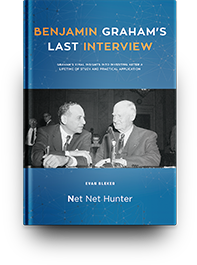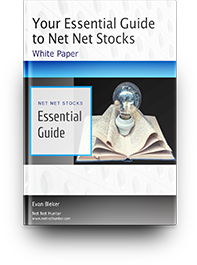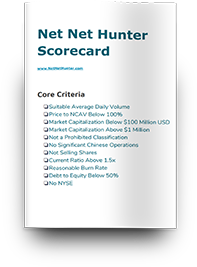Value Investing? Here's Why I Hate PE Ratios
I guess in the grand scheme of things hating a value investing statistic like PE Ratios might sound pretty silly. I suppose it would be better to hate famine or poverty. Hating diseases like cancer or that eczema you have on the end of your nose would make much more sense.
Still, I have my reasons.
You see, PEs have been the bane of my existence since I first started value investing.
A History of Maladjustment
Way back long ago in the early part of the 2000s I had just quit my job at the shipyard and had put-off buying my dream truck in favour of investing my money.
Intent on never having to work such a horrible job again, my plan was to retire in a few years time after investing in stocks. I quickly enrolled in university and focused on studying investments during every moment of free time I had. It was a passion bordering on obsessive-compulsion.
Not too long after I started consuming investment books I stumbled across one of Peter Lynch’s classic books. In it, on a few brilliantly articulated pages, Lynch described the strategy of buying earnings for cheap. Buying at a low price to earnings, Lynch made it seem, was both easy and profitable.
One Saturday afternoon I made my way to the family computer in our cramped den and started scanning Google Finance for low PE stocks. Hundreds came up.
Looking at the screen I was amazed just how cheap some companies were. Some had PEs of 5... and a select few even had PEs of 1!!
...I imagined plowing my money into a handful of these stocks and watching my value investing return shoot skywards on the computer screen. A slight grin came over me when I pictured what I’d do with the money.
But, soon I encountered a problem.
Looking at one of the S&P 500 stocks that I had picked out it was clear that something strange was going on with the company's earnings. The firm had essentially no operating income but a large after tax profit. How could a firm possibly have such large after tax earnings while barely scraping by on an EBITDA basis?
Fill your portfolio full of high potential, low risk, net net stocks. Click Here.
I had no idea but I knew I needed to look more into the firm’s financial statements.
Then it dawned on me that I should be checking the rest of the companies that I had selected for purchase. In nearly half of the companies that I had chosen, the financial statements showed “special items” as part of their income statement. Not only would I have to comb through the financial statements and read all of the notes to the financial statements of that first firm to get a sense of what the company’s true earnings were but I would have to do it for each and every company I selected.
I was frustrated but not about to give up value investing. If I had to get a sense of the company’s true earnings then it would be a small price to pay for being free financially in the not-so-distant future. I enrolled in a financial accounting course next semester and doubled down on my efforts.
A few months later I had put together a portfolio and even stuffed some money into a couple of stocks.
Things Were Looking Up
It wasn’t long before it dawned on me. If I had to adjust earnings due to a one-time event to get a better representation of what the company could actually earn, shouldn’t I also be looking at whether that single year was a true representation of what the company could actually earn? Yearly earnings bounce up and down, after all, and nothing said that the current year’s earnings had to be a good indication of the company’s actual earning power. Maybe it had an unusually good year.
I hit the value investing books yet again. This time I started looking through the writings of value investing legend Benjamin Graham. I noticed that Security Analysis was often mentioned by the top value practitioners but I opted for the Intelligent Investor and a few other well written value investing books.
The solution seemed obvious. I would have to go back through 7 to 10 years of financial statements adjusting figures before I could see how the current year’s earnings compared. After that, I could find the average of all of those years and invest based on a price below those average earnings.
This turned out to be a fair amount of work. As a student, I rarely had the time to conduct a detailed analysis for as many companies as I would have liked by pouring thorough each company's financial statements. Still, I was able to pinpoint a few firms that seemed promising.
I remember on a few occasions where I spent hours pouring over financial statements only to conclude that the company wasn’t worth investing in. I would always feel a bit depressed having spent so much time on analysis but also relieved that I had done the work and prevented myself from making a serious investment mistake.
Going through each analysis, I began to notice a trend. The firms I was looking at always seemed to grow in earnings, on average, year after year.
Often, things had really changed for the business over that 7 to 10 year stretch, as well. Looking at the number of stores that Starbucks had, for example, it was clear that they could earn a lot more money now than they could 10 years ago so the average earnings I was trying to use drastically understated the company’s actual earning power.
At the same time, if I shrunk the number of years averaged and only used the last 4 years then my earning power calculations were still problematic. For one, earnings were still understated but, in addition, using fewer years meant average earnings were more susceptible to cyclical swings in the firm’s business.
An obvious value investing solution was to only value firms that weren’t growing by very much but somehow that seemed like a bad idea. If I began doing that then I would be actively screening out the best companies available. I soon transitioned to calculating ROA, and then adjusted ROA, with just as many problems as I had encountered initially.
Then came the question of what constituted a low PE. Was I to use the current market PE, the inverse of some corporate bond yield, the average market PE of the S&P 500 over a number of years, or the historic PE for companies in that particular industry? How would I even arrive at that figure?
In the end, my 5 or 6 year experiment investing in firms trading at low PEs left me extremely frustrated. It was fairly obvious that Lynch had made things out to be much simpler than they actually were. I decided that value investing just wasn’t for me… so my plan was to give up and just put money into mutual funds.
And That’s When I Found Net Net Stocks.
There were a whole bunch of routes I could have taken at that point to adjust my value investing strategy. For the effort, however, none of them would have been as profitable or as easy as a net net stocks strategy.
Investing in the assets of a company has very strong advantages over investing based on earning power.
For one, while a company’s assets may be worth more or less than stated on the balance sheet, a proper analysis doesn’t usually have to include what a firm has done in the past. The numbers are the numbers, after all. If you want to adjust all of the balance sheet accounts to arrive at a more real world valuation then you’re more than welcome to.
But current asset figures don’t need a lot of adjustment to be useful. In my experience, NNWC investments, stocks whose net current assets have been adjusted downwards before subtracting total liabilities, don’t perform much differently than net net stocks. The added adjustment might not be that valuable.
Sure you should look back over two or three years to see how much NCAV has shrunk by but you only have to go back 2 or three years to get a good sense of the company’s current situation. And, you almost never have to worry about the effect the macro climate has had on the company’s past earnings.
When it comes down to it, liquid assets just don’t require that much detective work.
The catch, of course, is that great net net stock investment candidates can be tough to find. You can solve this problem by signing up for full Net Net Hunter membership. Not only do we have over 450 net net stocks to look at but we also dig through the listings to identify the best investment candidates. The money you could make off of even just one international net net stock would be enough to pay for full membership access for years.
Not ready for full membership? That’s fine. Just sign up for the free net net stock essential guide in the box below this article. No commitment, no obligation, and we keep your email address 100% confidential. Don’t wait. Sign up now so you can start making over 25% annual returns through net net stocks.
Article image (Creative Commons) by lamoix, edited by Net Net Hunter.






